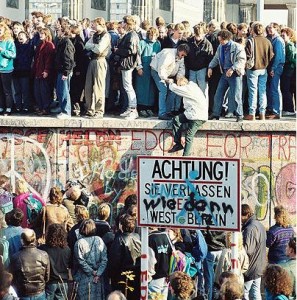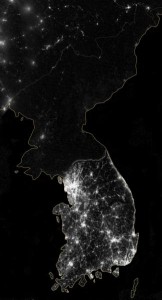The Cold War borders separated peoples with walls and fences – and also demonstrated the superiority of human freedom.
East and West Germany, North and South Korea, Hong Kong and Mainland China · Although each pair of countries started with people possessing the same history, culture, resources and knowledge, those that adopted the liberal system flourished while their socialist counterparts languished · A tale of countries and cars

The perennial debate between capitalism and socialism continues to keep millions engaged in endless debates in comment sections, on facebook pages and youtube videos and rebuttals. However, for the most part these debates revolve around partial and often ambiguous data taken from the very recent past. To deal with these questions properly requires a long-term perspective, one of years if not decades.
Nowadays, it’s almost impossible to isolate perfect ideal types of both systems for analysis, but the 20th century provides us with a number of fascinating events which provide us with the closest thing to real-world laboratory conditions: artificial borders which separated homogeneous populations sharing the same culture and the same skills into two states with opposing economic systems. The Koreans, Germans, Chinese and many other nations were torn from each other by such borders, and in time the differences were embedded and deepened.
Korea – North VS. South
The media likes to laugh at Kim-Jong Un, the young oddball dictator of North Korea, but it ignores the reign of terror with which he rules his citizens. Jong-Un is the third generation in a family of dictators put in place by Stalin. It is no coincidence that the dynasty’s cult of personality of this dynasty is very reminiscent of the cult surrounding the Sun of Nations. As with his predecessors in North Korea, secret informants and police, work camps and debilitating hunger are an integral part of the life of ordinary people in North Korea, completely isolated from the flourishing and progress experienced by its southern neighbor.
The Korean peninsula and its people were divided in the beginning of the Cold War after WWII, becoming one of the primary arenas for economic competition between West and East. The US helped to establish a liberal democracy in the south, while the communist USSR took the north under its wing. Thus, both new states started out with the same conditions, with the same past, traditions and culture. It may even be that North Korea had something of an advantage at the outset due to the great deal of pre-war Japanese industrialization and the vast natural resources in its territory.
65 years have passed since that historic split. While people in Seoul are working on the latest technological innovations, its communist neighbor is busy making empty threats against the world order, in a pathetic attempt to conceal the greatest economic failure in modern times. To emphasize the astronomic gap between the two countries, suffice to mention that entire GNP of North Korea is estimated at 40 billion dollars, while Samsung alone brings in 269 billion, 13 of which is pure profit.

A close look at the North Korean Communist Five Year Plans show just how absurd their allocation of resources really is. Aside from the enormous defense budget and expensive nuclear facilities, Pyongyang takes pride in the largest soccer stadium in the world capable of holding 150,000 people. But compared to Barcelona’s Camp Nou and England’s Wembley, the “1st of May” is not the site of sports events and rock concerts but rather mass government propaganda through military parades and public executions.
In spite of the fragile North-South cease-fire, the South Korean tiger will continue to race ahead, and giant corporations like Hyundai, Kia, LG and Samsung will continue to improve the lives of people around the world, while its Northern neighbor will depend in the near future on foreign handouts and rice stipends, to strengthen the most centralized state on the planet.
Germany – East VS. West
In the world before the collapse of the Communist Bloc in the beginning of the 1990s, the borders of Europe were even more tense than in Korea. The Berlin Wall symbolized the break between two countries: the Eastern under the control of the USSR and the Western under the wing of the liberal West. Thus, once again we are provided with an interesting historical test case for the two systems.
There are those who believe that Reagan and Thatcher’s assertive Cold War policies brought down the Berlin Wall, but in fact it was Western consumer culture which collapsed the Soviet Empire and the Warsaw Pact. The desire of East Germans for a Western standard of living greatly occupied the Stasi, East Germany’s notorious secret police, which tried unsuccessfully to fight the smuggling of goods in and people out of the communist part of Germany.
At the former crossing point between the two Germanies known as ‘Checkpoint Charlie’, the creative ways methods of smuggling goods and people are still on display. East German citizens crammed themselves next to active car engines, moving wheels and double roofs to flee for their lives from the stifling regime. At the time, observation points were put on the Western side of the Wall, which allowed tourists and free Germans to see what was going on over on the other side of the border as if it were some kind of game; clever graffiti tags line the wall which symbolized nothing but despair for those on the Eastern side.
In spite of the enormous potential of its heavy industry and the famous German work ethic, enormous gaps opened up between East and West – in all sectors in the German economy. It’s particularly hard to ignore the differences when it comes to the German car industry, which was a microcosm for changes in Germany and the rest of the world at the time. The Eastern side developed the Trabi/Travant – a slow and dangerous metal shell, which went from 0 to 90 kmh in no less than 22 seconds (!). The Western side, on the other hand, produced the fastest, safest and most modern cars at the time – known to us as ‘Audi’.
Thus did the differences between the socialist system, which paralyzes human freedom and creativity, and the capitalist system, were channeled into one German car plant. One picture is worth a thousand words, and here is an Audi compared to a Travant in 1990:

These gaps became glaringly apparent only with the fall of the Berlin Wall and the reunification of the two Germanies. Already in the morning after the reunification, a major study was conducted which examined the industrial volume and production capacities of both parts of Germany. It turned out, to the shock of many, that even if one ignores the enormous technological gap, West Germany’s GDP was 13 times that of East Germany. The same people, the same traditions, the same initial technical know-how – and such huge gaps! Is there any better way to explain this than economic freedom?
China and Hong Kong
Back to the Eastern part of the globe: the Korean wall still stands for now, but the division between China and Hong Kong is improving. As opposed to the hard dividing line between the Koreas, the Hong-Kong market economy is a shining example of freedom and development, a beacon which spurs Southeast Asia in general and China in particular to further economic growth and liberalization – China included.
The British conquered the barren island already in 1942. The the local population in Southeast China immigrated there throughout the 19th and 20th centuries in the wake of its impressive economic growth. The British ran the island as a flourishing trading station with a capitalist regime with completely flexible markets and almost no tariffs or taxes, while their Chinese neighbors maintained at the time a totalitarian empire, which after Mao Zedung’s takeover became the most populous communist country in the world. Here, too, is a starting point in which two populations of similar background functioned under opposing regimes.
As in East Germany, here too Chinese labor immigrants – envious of the flourishing and progress on the Kowloon peninsula in Hong Kong – flooded the island even though this immigration was illegal and rigorously combatted by the communist regime. In 1997, when Hong Kong was formally transferred from the British crown to the Chinese authorities (it maintained its independence), almost a million Chinese immigrated there as part of a family unification law.
Hong Kong has been at the top of the Heritage Foundation’s economic freedom index for years, while China is placed at 137 between Cameroon and Liberia. The raw data also does not lie: the Chinese worker earns less than a third of his Hong-Kong counterpart – for the same work. Nevertheless, the economic liberalization which China has undergone in recent years, is showing a trend not only of improvement but also of closing the aforementioned gap. The gaping differences between what took place in Hong-Kong during British rule, and China’s economic stagnation prior to its recent reforms, are further testimony to the possibilities of progress inherent in reducing centralization and revoking stifling regulation.
People Vote With Their Feet
Throughout the world, political borders tell an important and fascinating story. The Spanish movement into the German workforce, the massive Mexican flood into America, and even the Eritreans moving into our own little country show just how much people need freedom.
Aside from the clear-cut cases of Germany, Korea and China, one can see that the connection between freedom and economic growth is extremely strong. These extreme cases indeed do not provide a full reply to all sorts of present-day discussions about a “third way” and other such slogans, but they do shed light on the enormous advantage of liberal democracies in creating wealth and happiness. It’s important to remember that the Berlin Wall, the Korean fence and the Hong-Kong border were built to prevent people living under socialist regimes from fleeing, not the other way around.
Remove the walls, and people will choose freedom.
English translation by Avi Woolf.
To receive updates on new articles in English, join Mida on Facebook or Twitter or join our mailing list.




